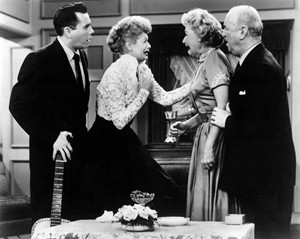

Television in the 1950s - USA

CBS Television, Public domain, via Wikimedia Commons
Television broadcasting began in the United States in 1941 with just two stations in New York. Growth of television ownership was slow at first. The Second World War meant the nation had other priorities. In 1947 just 8,000 households had television sets.
In the 1950s television ownership boomed. By 1950 nearly four million households had television sets. It was still less than 9% of the population. By 1955 67% of households had a television [2] and by 1959 86%.
To start with broadcasters were concerned that television might not be economically viable. But advertising revenue brought fortunes for the broadcasters, the stars and the companies advertising products.
What people watched on television changed over the course of the decade. To start with variety shows, comedy and drama were popular. Some of the drama was of outstanding quality. 'The Philco Television Playhouse' was well-regarded. Some leading actors, Paul Newman, Rob Steiger, Sidney Poitier and Joanne Woodward, first appeared on television drama.
In 1949 the top ten TV shows were:
- Texaco Star Theater: The Milton Berle Show (season 2) (1949-50) (NBC)
- Toast of the Town (Ed Sullivan) (season 2) (1949-50) (CBS)
- Arthur Godfrey's Talent Scouts (CBS)
- Fireball Fun For All (NBC)
- Philco Television Playhouse (season 2) (1949-50) (NBC)
- Fireside Theatre (season 2) (1949-50) (NBC)
- The Goldbergs (1949-50)(CBS)
- Suspense (season 2) (1949-50) (CBS)
- Ford Theater (season 2) (1949-50) (CBS)
- Cavalcade of Stars (season 1) (1949-50) (DuMont)
Source: US TV Nielsen Ratings 1949-1950
Presenters Milton Berle, known as 'Mr Television', Arthur Godfrey and Ed Sullivan became household names.

Producer: Fairbanks (Jerry) Productions Sponsor: Eastern Air Lines, Public Domain, via Wikimedia Commons
Arthur Godfrey was a big television star in the early 1950s. He topped the ratings in the 1951-2 season, but blew it in 1953. He fired singer Julius La Rosa on air on his radio show. He had no idea of how the public expected stars to behave.
The biggest star of the 1950s was Lucille Ball. In her comedy show 'I Love Lucy' she played Lucy Ricardo, a suburban housewife. She schemed to get into her bandleader husband's show. The husband, Ricky Ricardo, was Desi Arnaz, who was Lucille Ball's real life husband. The show debuted in 1951 and was the third most-watched programme in the 1951-2 season. 'I Love Lucy' then topped the TV ratings for the next six years.
Variety shows also attracted huge audiences. Ed Sullivan profited from Arthur Godfrey's mistake. The Ed Sullivan show was the most-watched variety show of the second half of the 1950s, if not the whole decade.
Another genre began in the 1950s, the game show. The advertising revenue from television allowed large prizes for the contestants. 'The $64,000 Question' offered a huge prize in 1950s' money. In 'The Price is Right' contestants demonstrated their knowledge of consumer products by guessing the price. They could win thousands of dollars' worth of goods.
The police drama also debuted in the 1950s. 'Dragnet' started in 1951. It stared Jack Webb as Sergeant Joe Friday. The series was supposed to be based on real-life police investigations. The names of the people were changed.

CBS Television, Public domain, via Wikimedia Commons
TV westerns
The most successful genre of the late 1950s was the western. 'Gunsmoke' topped the ratings from 1958 to 1961. It was still getting large audiences in the 1970s.
Some of the other popular TV westerns from the 1950s were:
- Wagon Train
- Have Gun Will Travel
- Tales of Wells Fargo
- Wyatt Earp
- Cheyenne
- Maverick
- Restless Gun
- The Rifleman
- Lawman
- Wanted Dead or Alive
- Rawhide
Rawhide launched the career of Clint Eastwood as Rowdy Yates.

Richard Nixon; program paid for by Republican National Committee.Uploaded by Wehwalt at en.wikipedia, Public domain, via Wikimedia Commons
Politics and TV
The 1950s was the first television decade. Politics, just like any other product, was packaged and marketed on television.
Dwight D Eisenhower (Ike) took the advice of his team and broadcast a series of 'spots' in the 1952 election campaign. In these short broadcasts he pretended to answer real voters' questions. The spots were a huge success and helped him trounce his opponent, Adlai Stevenson. Stevenson also broadcast on television, but he preferred long speeches. Few people listened to them. Stevenson was a better orator than Eisenhower. In the pre-television era he might have done better. It was the way Ike broadcasts were packaged that gave him the edge.
Ike's running mate, Richard Nixon, made the most famous political broadcast of the 1950s. Nixon was accused of accepting gifts from wealthy donors. He went live on-air to refute the allegations. The speech ended with Nixon admitting to receiving one gift, a black-and-white Cocker Spaniel. His six-year-old daughter had said he had always wanted a dog. She called the dog 'Checkers'. Everyone ended up feeling sorry for Nixon! The broadcast showed what television could do for those that knew how to manipulate it.
References
[1] Figures derived from 'Historical Statistics of the United States - Colonial Times to 1957', prepared by the Bureau of Census, page 491
By Steven Braggs, November 2021


Comments